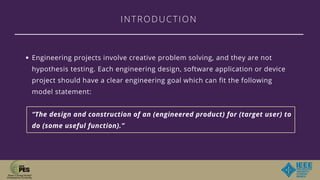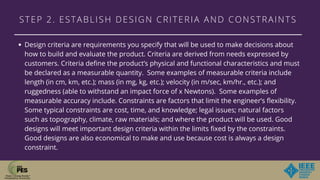How to build your engineering project
- 1. How to build your engineering project PRESENTED BY : MUHAMMAD SHORRAB
- 2. INTRODUCTION Engineering projects involve creative problem solving, and they are not hypothesis testing. Each engineering design, software application or device project should have a clear engineering goal which can fit the following model statement: “The design and construction of an (engineered product) for (target user) to do (some useful function).”
- 3. INTRODUCTION You will use the engineering design process to create your fair entry. This process is typical of those used by practicing engineers; the definition of terms and the number of steps may vary, but these are “essential steps.” Your very first step is to start a project notebook in which you will record every step of your process and the results of your design efforts. The process is iterative, meaning the designer will often repeat steps until he or she is confident the design will meet the needs. Note: the terms product, invention, project, design, and solution are often used interchangeably in Fair Guidelines.
- 4. THE ENGINEERING DESIGN PROCESS Define a need; express as a goal Establish design criteria and constraints Evaluate alternative designs Build a prototype of best design Test and evaluate the prototype using the design criteria Analyze test results, make design changes, and retest Communicate the design
- 5. STEP 1. IDENTIFY A NEED The need (also called the problem you are solving or the Engineering Goal) is frequently identified by customers–the users of the product. The customer could be a retail consumer or the next team in a product development. Customers may express needs by describing a product (I need a car) or as a functional requirement (I need a way to get to school). The need should be described in a simple statement that includes what you are designing (the product), who it is for (customer), what need does it satisfy (problem to solve), and how does it improve previous designs (easier to use, less expensive, more efficient, safer).
- 6. STEP 2. ESTABLISH DESIGN CRITERIA AND CONSTRAINTS Design criteria are requirements you specify that will be used to make decisions about how to build and evaluate the product. Criteria are derived from needs expressed by customers. Criteria define the product’s physical and functional characteristics and must be declared as a measurable quantity. Some examples of measurable criteria include length (in cm, km, etc.); mass (in mg, kg, etc.); velocity (in m/sec, km/hr., etc.); and ruggedness (able to withstand an impact force of x Newtons). Some examples of measurable accuracy include. Constraints are factors that limit the engineer’s flexibility. Some typical constraints are cost, time, and knowledge; legal issues; natural factors such as topography, climate, raw materials; and where the product will be used. Good designs will meet important design criteria within the limits fixed by the constraints. Good designs are also economical to make and use because cost is always a design constraint.
- 7. STEP 3. EVALUATE ALTERNATIVE DESIGNS AND CREATE YOUR TEST PLAN Your research into possible solutions will reveal what has been done to satisfy similar needs. You’ll discover where knowledge and science limit your solutions, how previous solutions may be improved, and what different approaches may meet design objectives. You should consider at least two or three alternative designs and consider using available technology, modifying current designs, or inventing new solutions. Superior work will demonstrate tradeoff analyses such as comparing the strength vs. cost of various bridge-building materials.It’s important to document in your project notebook how you chose and evaluated alternative designs. Can you defend your choices to the judges?. You will develop an initial test plan describing how you will test the design criteria and constraints you listed in Step 2.
- 8. STEP 4. BUILD A PROTOTYPE OF BEST DESIGN Use your alternative analyses to choose the design that best meets criteria considering the constraints, then build a prototype. A prototype is the first full scale and usually functional form of a new type or design.
- 9. STEP 5. TEST AND EVALUATE THE PROTOTYPE AGAINST IMPORTANT DESIGN CRITERIA TO SHOW HOW WELL THE PRODUCT MEETS THE NEED You must test your prototype under actual or simulated operating conditions. Make sure you test all of your criteria and constraints to evaluate the success of your prototype.
- 10. STEP 6. ANALYZE TEST RESULTS, MAKE DESIGN CHANGES AND RETEST Testing will disclose some deficiencies in your design. Sometimes the testing fails completely and sends the designer “back to the drawing board.” Make corrections and retest OR prepare an analysis of what went wrong and how you will fix it. As always, document your analyses, fixes, and retests in your notebook.
- 11. STEP 7. COMMUNICATE THE DESIGN The designer’s real product is the description of a design from which others will build the product. Use your notebook and the fair exhibit to communicate the design to your customer and the judges. Your product description will be conveyed in drawings, photos, materials lists, assembly instructions, test plans and results. Consider listing lessons learned so future designers need not repeat any of your “frustrations.” You’ll have clear instructions on how to produce your design, along with production cost estimates.
- 12. STEP 8. WHAT ARE YOU WAITING FOR?! BUILD YOUR PROJECT FREELY Prepare your engineering project exhibit board think without boundaries yes, you can do it, do not be afraid always remember "The honor of trying success"












